2022届高中英语二轮复习语法专项第08讲时态和语态讲义教案
文档属性
| 名称 | 2022届高中英语二轮复习语法专项第08讲时态和语态讲义教案 | 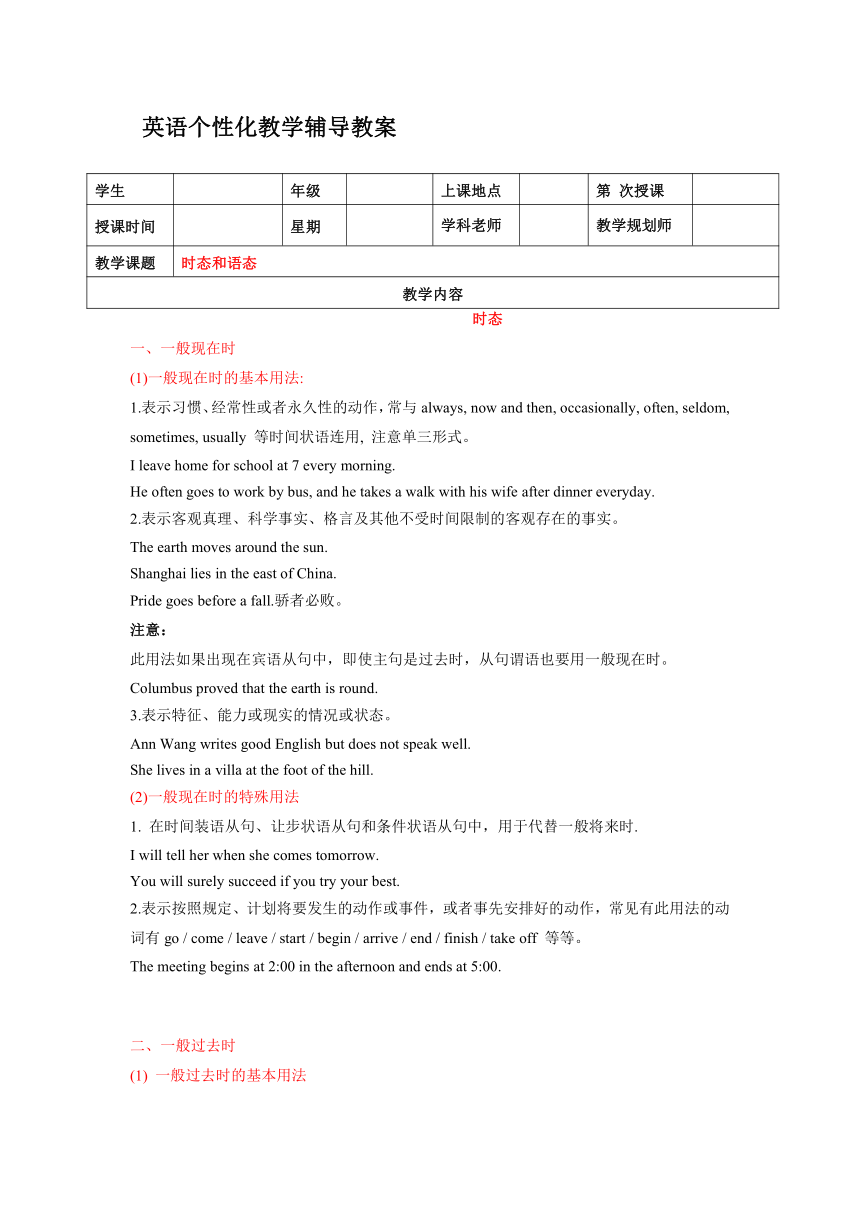 | |
| 格式 | zip | ||
| 文件大小 | 24.8KB | ||
| 资源类型 | 教案 | ||
| 版本资源 | 人教版(2019) | ||
| 科目 | 英语 | ||
| 更新时间 | 2022-02-04 20:22:46 | ||
图片预览

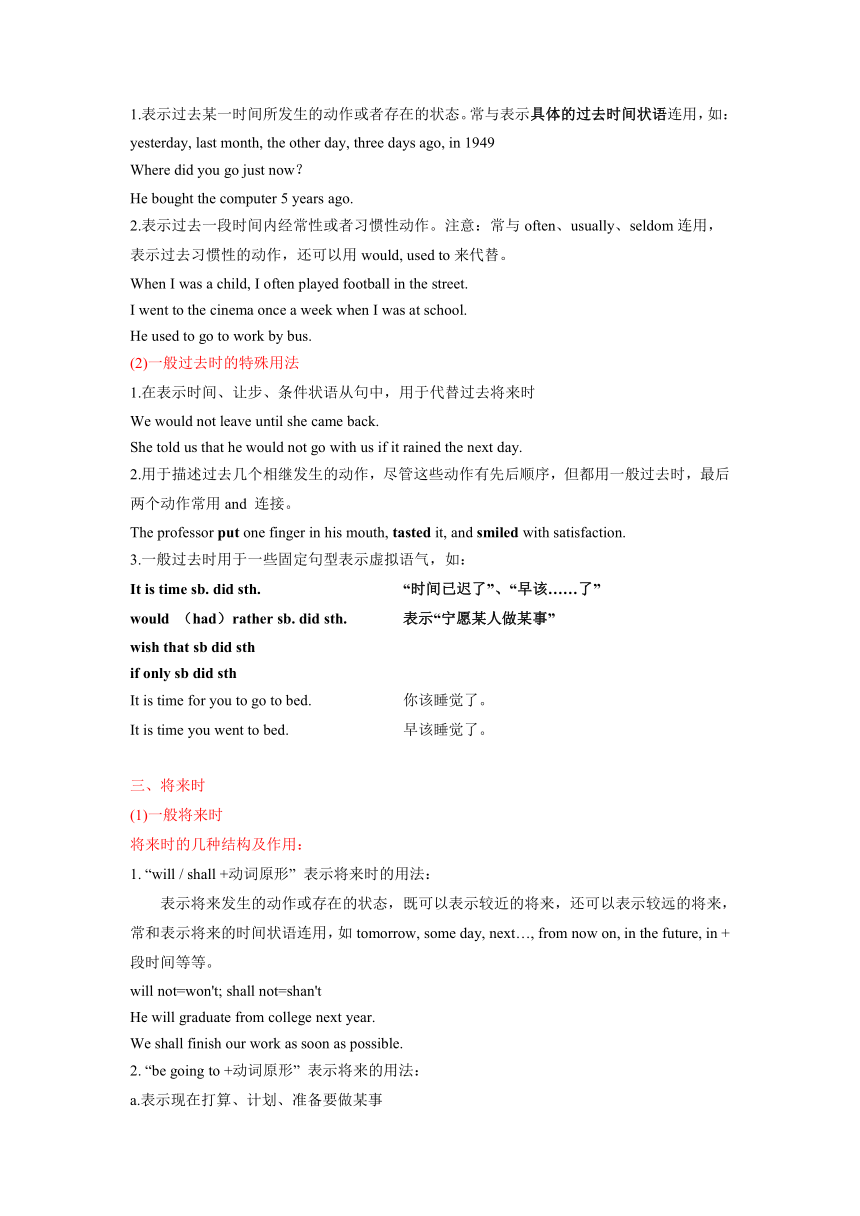
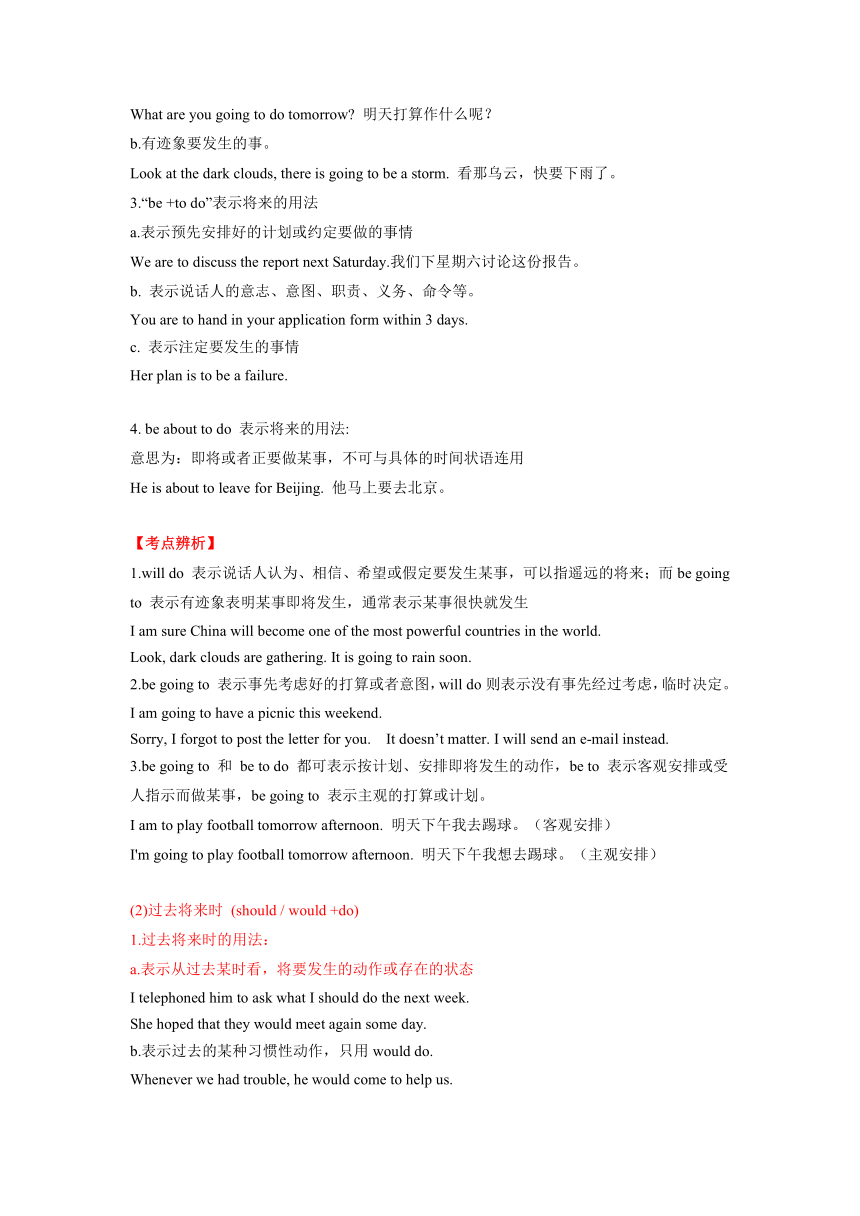
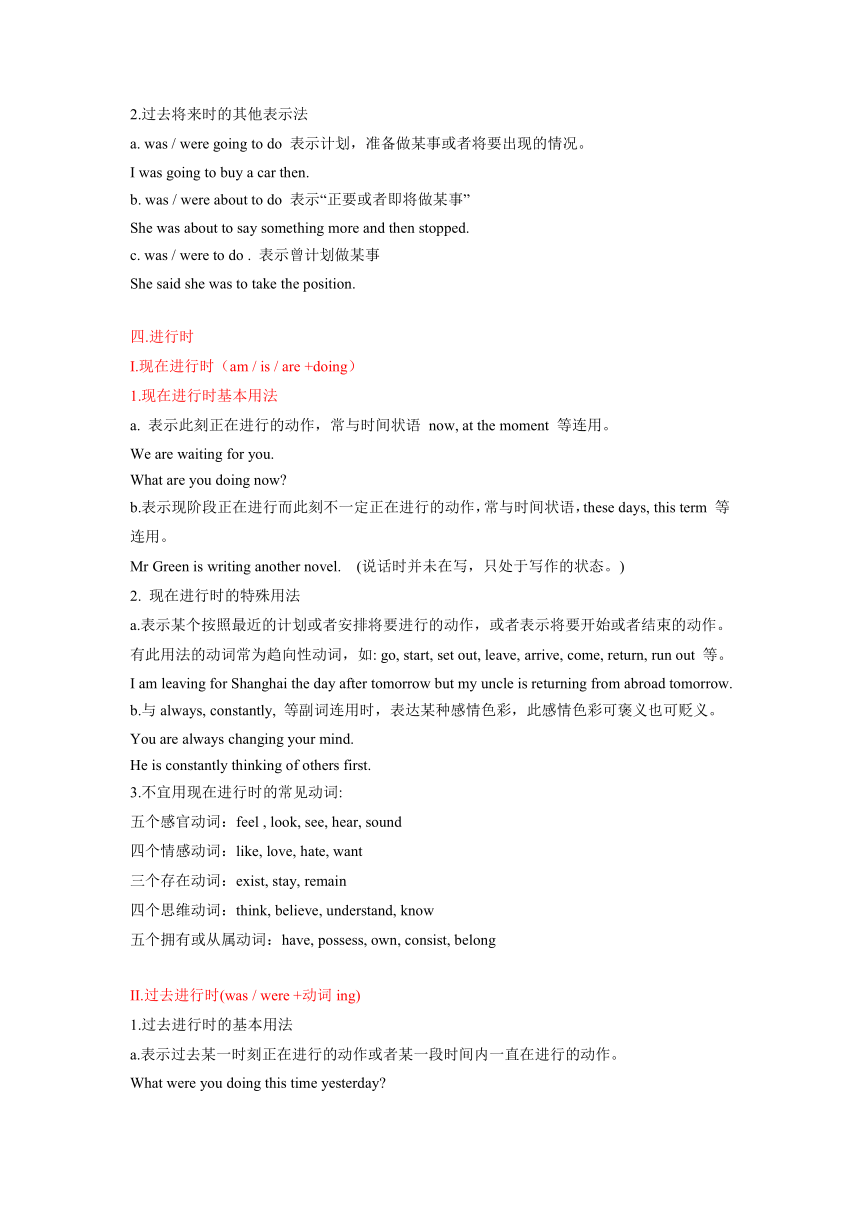
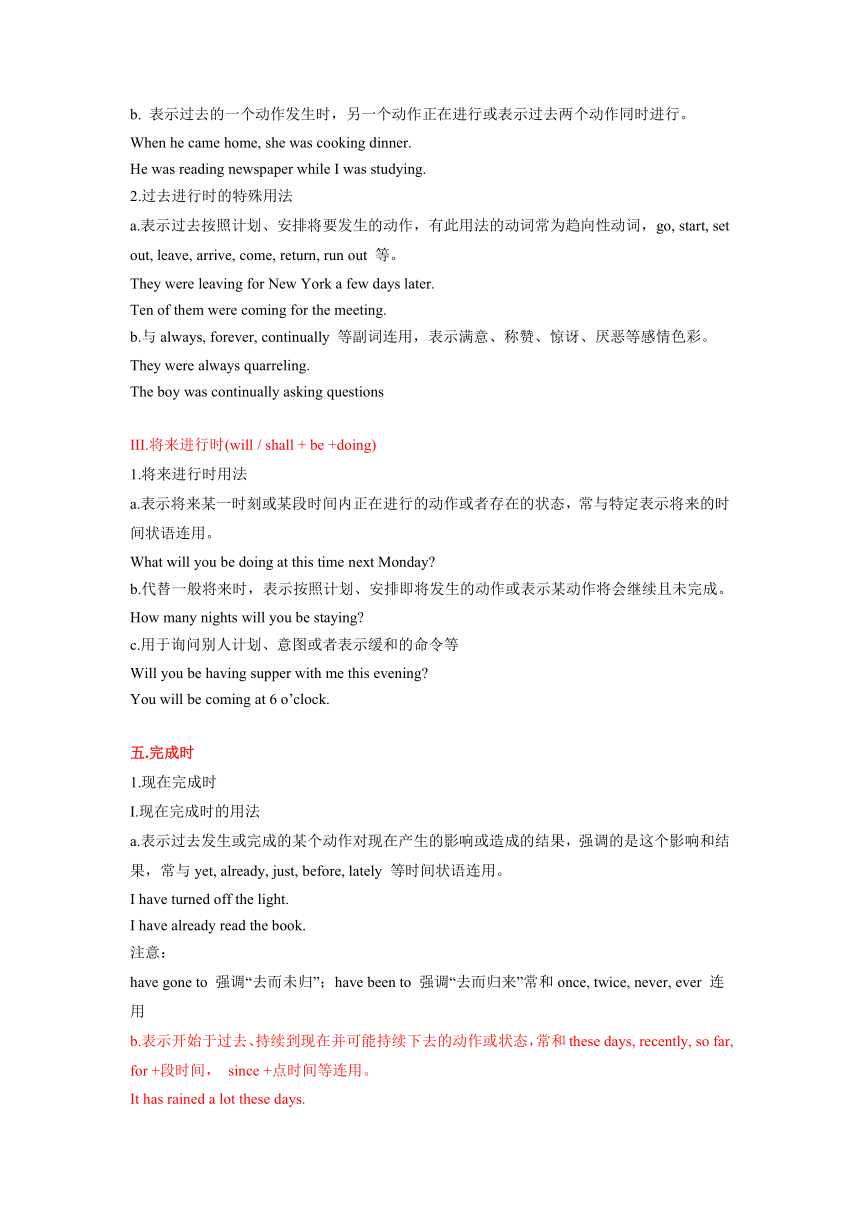
文档简介
英语个性化教学辅导教案
学生 年级 上课地点 第 次授课
授课时间 星期 学科老师 教学规划师
教学课题 时态和语态
教学内容
时态
一、一般现在时
(1)一般现在时的基本用法:
1.表示习惯、经常性或者永久性的动作,常与always, now and then, occasionally, often, seldom, sometimes, usually 等时间状语连用, 注意单三形式。
I leave home for school at 7 every morning.
He often goes to work by bus, and he takes a walk with his wife after dinner everyday.
2.表示客观真理、科学事实、格言及其他不受时间限制的客观存在的事实。
The earth moves around the sun.
Shanghai lies in the east of China.
Pride goes before a fall.骄者必败。
注意:
此用法如果出现在宾语从句中,即使主句是过去时,从句谓语也要用一般现在时。
Columbus proved that the earth is round.
3.表示特征、能力或现实的情况或状态。
Ann Wang writes good English but does not speak well.
She lives in a villa at the foot of the hill.
(2)一般现在时的特殊用法
1. 在时间装语从句、让步状语从句和条件状语从句中,用于代替一般将来时.
I will tell her when she comes tomorrow.
You will surely succeed if you try your best.
2.表示按照规定、计划将要发生的动作或事件,或者事先安排好的动作,常见有此用法的动词有go / come / leave / start / begin / arrive / end / finish / take off 等等。
The meeting begins at 2:00 in the afternoon and ends at 5:00.
二、一般过去时
(1) 一般过去时的基本用法
1.表示过去某一时间所发生的动作或者存在的状态。常与表示具体的过去时间状语连用,如:yesterday, last month, the other day, three days ago, in 1949
Where did you go just now?
He bought the computer 5 years ago.
2.表示过去一段时间内经常性或者习惯性动作。注意:常与often、usually、seldom连用,表示过去习惯性的动作,还可以用would, used to来代替。
When I was a child, I often played football in the street.
I went to the cinema once a week when I was at school.
He used to go to work by bus.
(2)一般过去时的特殊用法
1.在表示时间、让步、条件状语从句中,用于代替过去将来时
We would not leave until she came back.
She told us that he would not go with us if it rained the next day.
2.用于描述过去几个相继发生的动作,尽管这些动作有先后顺序,但都用一般过去时,最后两个动作常用and 连接。
The professor put one finger in his mouth, tasted it, and smiled with satisfaction.
3.一般过去时用于一些固定句型表示虚拟语气,如:
It is time sb. did sth. “时间已迟了”、“早该……了”
would (had)rather sb. did sth. 表示“宁愿某人做某事”
wish that sb did sth
if only sb did sth
It is time for you to go to bed. 你该睡觉了。
It is time you went to bed. 早该睡觉了。
三、将来时
(1)一般将来时
将来时的几种结构及作用:
1. “will / shall +动词原形” 表示将来时的用法:
表示将来发生的动作或存在的状态,既可以表示较近的将来,还可以表示较远的将来,常和表示将来的时间状语连用,如tomorrow, some day, next…, from now on, in the future, in +段时间等等。
will not=won't; shall not=shan't
He will graduate from college next year.
We shall finish our work as soon as possible.
2. “be going to +动词原形” 表示将来的用法:
a.表示现在打算、计划、准备要做某事
What are you going to do tomorrow 明天打算作什么呢?
b.有迹象要发生的事。
Look at the dark clouds, there is going to be a storm. 看那乌云,快要下雨了。
3.“be +to do”表示将来的用法
a.表示预先安排好的计划或约定要做的事情
We are to discuss the report next Saturday.我们下星期六讨论这份报告。
b. 表示说话人的意志、意图、职责、义务、命令等。
You are to hand in your application form within 3 days.
c. 表示注定要发生的事情
Her plan is to be a failure.
4. be about to do 表示将来的用法:
意思为:即将或者正要做某事,不可与具体的时间状语连用
He is about to leave for Beijing. 他马上要去北京。
【考点辨析】
1.will do 表示说话人认为、相信、希望或假定要发生某事,可以指遥远的将来;而be going to 表示有迹象表明某事即将发生,通常表示某事很快就发生
I am sure China will become one of the most powerful countries in the world.
Look, dark clouds are gathering. It is going to rain soon.
2.be going to 表示事先考虑好的打算或者意图,will do则表示没有事先经过考虑,临时决定。
I am going to have a picnic this weekend.
Sorry, I forgot to post the letter for you. It doesn’t matter. I will send an e-mail instead.
3.be going to 和 be to do 都可表示按计划、安排即将发生的动作,be to 表示客观安排或受人指示而做某事,be going to 表示主观的打算或计划。
I am to play football tomorrow afternoon. 明天下午我去踢球。(客观安排)
I'm going to play football tomorrow afternoon. 明天下午我想去踢球。(主观安排)
(2)过去将来时 (should / would +do)
1.过去将来时的用法:
a.表示从过去某时看,将要发生的动作或存在的状态
I telephoned him to ask what I should do the next week.
She hoped that they would meet again some day.
b.表示过去的某种习惯性动作,只用would do.
Whenever we had trouble, he would come to help us.
2.过去将来时的其他表示法
a. was / were going to do 表示计划,准备做某事或者将要出现的情况。
I was going to buy a car then.
b. was / were about to do 表示“正要或者即将做某事”
She was about to say something more and then stopped.
c. was / were to do . 表示曾计划做某事
She said she was to take the position.
四.进行时
I.现在进行时(am / is / are +doing)
1.现在进行时基本用法
a. 表示此刻正在进行的动作,常与时间状语 now, at the moment 等连用。
We are waiting for you.
What are you doing now
b.表示现阶段正在进行而此刻不一定正在进行的动作,常与时间状语,these days, this term 等连用。
Mr Green is writing another novel. (说话时并未在写,只处于写作的状态。)
2. 现在进行时的特殊用法
a.表示某个按照最近的计划或者安排将要进行的动作,或者表示将要开始或者结束的动作。有此用法的动词常为趋向性动词,如: go, start, set out, leave, arrive, come, return, run out 等。
I am leaving for Shanghai the day after tomorrow but my uncle is returning from abroad tomorrow.
b.与always, constantly, 等副词连用时,表达某种感彩,此感彩可褒义也可贬义。
You are always changing your mind.
He is constantly thinking of others first.
3.不宜用现在进行时的常见动词:
五个感官动词:feel , look, see, hear, sound
四个情感动词:like, love, hate, want
三个存在动词:exist, stay, remain
四个思维动词:think, believe, understand, know
五个拥有或从属动词:have, possess, own, consist, belong
II.过去进行时(was / were +动词ing)
1.过去进行时的基本用法
a.表示过去某一时刻正在进行的动作或者某一段时间内一直在进行的动作。
What were you doing this time yesterday
b. 表示过去的一个动作发生时,另一个动作正在进行或表示过去两个动作同时进行。
When he came home, she was cooking dinner.
He was reading newspaper while I was studying.
2.过去进行时的特殊用法
a.表示过去按照计划、安排将要发生的动作,有此用法的动词常为趋向性动词,go, start, set out, leave, arrive, come, return, run out 等。
They were leaving for New York a few days later.
Ten of them were coming for the meeting.
b.与always, forever, continually 等副词连用,表示满意、称赞、惊讶、厌恶等感彩。
They were always quarreling.
The boy was continually asking questions
III.将来进行时(will / shall + be +doing)
1.将来进行时用法
a.表示将来某一时刻或某段时间内正在进行的动作或者存在的状态,常与特定表示将来的时间状语连用。
What will you be doing at this time next Monday
b.代替一般将来时,表示按照计划、安排即将发生的动作或表示某动作将会继续且未完成。
How many nights will you be staying
c.用于询问别人计划、意图或者表示缓和的命令等
Will you be having supper with me this evening
You will be coming at 6 o’clock.
五.完成时
1.现在完成时
I.现在完成时的用法
a.表示过去发生或完成的某个动作对现在产生的影响或造成的结果,强调的是这个影响和结果,常与yet, already, just, before, lately 等时间状语连用。
I have turned off the light.
I have already read the book.
注意:
have gone to 强调“去而未归”;have been to 强调“去而归来”常和once, twice, never, ever 连用
b.表示开始于过去、持续到现在并可能持续下去的动作或状态,常和these days, recently, so far, for +段时间, since +点时间等连用。
It has rained a lot these days.
She has worked in the school for 10 years.
II.现在完成时的时间状语
a.凡是"完成时态"都表示,不知道也不管动作发生的具体时间, 所以在使用现在完成时的句子里,不可以带有表示具体过去时间的状语,如:yesterday, last week ( month ,year , etc.) ,two weeks ago ,in 1999等;
b.在以when提问的特殊疑问中不能用现在完成时; ago不能用于现在完成时的句子里,因为它表示从现在算起的以前某个时间,属于表示具体过去时间的状语。但是可以用before 来表示"以前"的意义,因为它只表示"以前",而不知什么时候的以前。
c.如果是不表示连续性的动词用于现在完成时的句子,不可以和以for表示的"一段时间"的状语连用。在这种情况下,应该用"It has been …;since…"的句式来表达。
He has joined the army for five years. (错误)
It has been five years since he joined the army.(正确)
瞬间性动词可表示某一动作的完成,但是当后面有表示一段时间的状语时要变成相应的延续性动词,瞬间性动词改为延续性动词
buy-- had leave--be away
stop--be over die- be dead
arrive-- be in/at (from) begin/start -be on
come/go--be in/at fall asleep - be asleep
put on- be on go out- be out
get married- be married join-been a member of
come to work – work begin to study-study
finish/end-be over borrow—kept
become- be
II.现在完成时的常用固定句型
1. It / This / That / is the first / second , third …) time that …从句要用现在完成时
This is the first time that I have watched a play.
2.This / That / It is +最高级+名词 that 从句用现在完成时
This is the best film that I’ve seen.
3. It +have been +一段时间+ since …,主句常用现在完成时(也可用一般现在时)
It has been / is 6 years since I came here.
2.过去完成时 (had +动词ed形式)
1.过去完成时的用法
a. 表示过去某一时刻或者某一动作之前已经完成的动作,时间定位是“过去的过去”。句中一般有明确表示“过去的过去”的时间,如by, by the end of, by the time, until, when, before 等引出的表示过去的时间状语,但有时需要通过上下文来判断
They had got everything ready before I came.
By nine o’clock last night, we had finished most of the work.
b. 表示从过去某一时刻开始,一直持续到过去另一时刻的动作或状态,常和for, since 构成的时间状语连用。
I had been at the bus stop for 30 minutes when a bus finally came.
c.含有定语从句的主从复合句中,若主从复合句叙述的是过去的事情,则先发生的动作常用过去完成时。
She returned the book that she had borrowed.
d.过去完成时常常用在宾语从句(或间接引语)中,这时从句谓语动作发生在谓语动作之前。
She said that she had finished her homework.
e.在含有时间、条件、原因、方式,若主从句动作的发生有先后关系,动作在前的要用过去完成时,动作在后的要用一般过去时。
After he had finished, his homework, he went to bed.
f. want, hope, mean, plan, intend 等动词的过去完成时可用来表示过去未曾实现的想法、希望、打算或意图,意为“本来……”
We had intended to come and see you.
2.过去完成时常用固定句型
I.主语+had hardly, scarcely (no sooner )+过去分词+ when / than ,从句用一般过去时;hardly, scarcely, no sooner, 位于句首时,主要用倒装。
Hardly had he began to speak when the audience interrupted him.
II. It was+一段时间+since 从句。since 从句用过去完成时。
It was at least 3 months since I had left Beijing.
III. It was the first / second …time +that 从句,从句用过去完成时
It was the first time that I had chatted online in English.
IV. By the time …(表示过去时间的句子)+主句 (过去完成时)
By the time he was ten, Tom had built a chemistry lab.
V. By the end of +(表示过去的时间)
By the end of last term we had learned 12 units.
3.将来完成时 (will / shall +have +动词ed)
1.将来完成时的用法:
a. 表示在将来某时/ 某动作之前完成的动作。常与时间状语“by / before +将来时间 ”
By the time tomorrow you will have arrived in Shenyang.
b. 在时间状语从句和条件状语从句中,通常用现在完成时代替将来完成时。
You will come to like the subject after you have studied it for some time.
六.完成进行时
1.现在完成进行时的用法 (have / has been doing)
a. 表示动作从过去某时开始一直持续到现在,并有可能持续下去。
Tom has been working hard since the new term began.
b. 表示到目前为止的一段时间动作时断时续,反复发生。
You have been telling me not to be late all the way.
c.表示某种感彩
You have been daydreaming but make no effort.
2.过去完成进行时的用法 (had been doing)
a. 表示在过去某一时间之前一直进行的动作货存在的状态
I had been looking for it for days before I found it.
b. 表示过去某段时间内反复发生的动作
He had been asking the same questions.
c.表示某种感彩
What had he been doing on earth
语态
1.带双宾语的动词的被动语态
带双宾语的动词变为被动结构时,一般将主动结构中的间接宾语变为被动结构中的主语,直接宾语不变。如将主动结构中的直接宾语变为被动结构中的主语,间接宾语之前则应加上相应的介词。
My friend lent me these books.我的朋友借给我这些书。
→I was lent these books by my friend. →These books were lent to me by my friend. 这些书是朋友借给我的。
2.带复合宾语的动词的被动语态
带复合宾语的动词变被动时,一般将主动结构中的宾语变为被动结构中的主语,宾语补足语不变,但在作用上变成主语补足语。作主语补足语的可以是名词(短语)、形容词(短语)或非限定动词(短语),其中不定式都必须带to。
The farmer made the horses work the whole day. 农民让马干了一整天活。
→The horses were made to work the whole day. 马被驱使着干了一整天活。
3.含that宾语从句的被动语态
当含有that宾语从句的主动句变成被动句时,通常以间接宾语作为主语,that从句不变。
She told me that the teacher would come soon. 她告诉我老师很快就来。
→I was told that the teacher would come soon. 我被告知老师很快就来。
4. 特殊结构的被动形式
(1)be+过去分词+不定式
He is said to know three languages. 据说他懂三种语言。
She is reported to have broken a world record. 据报道她打破了一项世界纪录。
(2)It+be+过去分词+从句
It is reported that he has some supernatural powers. 据说他有某些特异功能。
(3)get+done
常考结构如下:
get married结婚;get engaged订婚;get hurt/wounded受伤;get lost迷路;get drunk喝醉;get changed换衣服;get paid得到工资;get dressed穿好衣服;get caught/stuck/trapped被困;get run over被(车)轧
5.不用被动语态的动词(短语)
(1)感官动词feel,look,smell,taste,sound等。
(2)当cut,write,read,sell,wear,wash,cook,shut,drink等词表示某种性质且动词带状语修饰语时。
(3)break out,take place,give out,work out,turn out,run out,consist of等。
(4)hold,possess,fit,last(持续,够……之用)等。
My pen writes smoothly. 我的钢笔写起来很流畅。
Cotton feels soft. 棉花摸起来很柔软。
The plan worked out successfully. 计划进行得很成功。
6.被动语态和系表结构
被动语态表示动作,句子主语是动作的对象;系表结构说明主语所处的状态,其中的过去分词具有形容词的性质。
The cup was broken by my brother. 茶杯是我弟弟打碎的。(被动语态)
The cup is broken.茶杯碎了。(系表结构)
7.主动形式表被动意义
(1)有些形容词之后作状语的不定式用主动语态表被动意义,相当于在不定式前省略for sb.,该不定式与主语存在着动宾关系,常见的此类形容词有easy,difficult,hard,comfortable等。
The problem is too difficult to work out. 这个问题很难解出来。
(2)不定式to let,to blame等表被动意义。
The car is to let.汽车出租。
(3)want,require,need,worth,deserve后接动词ing形式用主动表示被动意义。
These flowers want/need/require watering. 这些花需要浇水。
学生 年级 上课地点 第 次授课
授课时间 星期 学科老师 教学规划师
教学课题 时态和语态
教学内容
时态
一、一般现在时
(1)一般现在时的基本用法:
1.表示习惯、经常性或者永久性的动作,常与always, now and then, occasionally, often, seldom, sometimes, usually 等时间状语连用, 注意单三形式。
I leave home for school at 7 every morning.
He often goes to work by bus, and he takes a walk with his wife after dinner everyday.
2.表示客观真理、科学事实、格言及其他不受时间限制的客观存在的事实。
The earth moves around the sun.
Shanghai lies in the east of China.
Pride goes before a fall.骄者必败。
注意:
此用法如果出现在宾语从句中,即使主句是过去时,从句谓语也要用一般现在时。
Columbus proved that the earth is round.
3.表示特征、能力或现实的情况或状态。
Ann Wang writes good English but does not speak well.
She lives in a villa at the foot of the hill.
(2)一般现在时的特殊用法
1. 在时间装语从句、让步状语从句和条件状语从句中,用于代替一般将来时.
I will tell her when she comes tomorrow.
You will surely succeed if you try your best.
2.表示按照规定、计划将要发生的动作或事件,或者事先安排好的动作,常见有此用法的动词有go / come / leave / start / begin / arrive / end / finish / take off 等等。
The meeting begins at 2:00 in the afternoon and ends at 5:00.
二、一般过去时
(1) 一般过去时的基本用法
1.表示过去某一时间所发生的动作或者存在的状态。常与表示具体的过去时间状语连用,如:yesterday, last month, the other day, three days ago, in 1949
Where did you go just now?
He bought the computer 5 years ago.
2.表示过去一段时间内经常性或者习惯性动作。注意:常与often、usually、seldom连用,表示过去习惯性的动作,还可以用would, used to来代替。
When I was a child, I often played football in the street.
I went to the cinema once a week when I was at school.
He used to go to work by bus.
(2)一般过去时的特殊用法
1.在表示时间、让步、条件状语从句中,用于代替过去将来时
We would not leave until she came back.
She told us that he would not go with us if it rained the next day.
2.用于描述过去几个相继发生的动作,尽管这些动作有先后顺序,但都用一般过去时,最后两个动作常用and 连接。
The professor put one finger in his mouth, tasted it, and smiled with satisfaction.
3.一般过去时用于一些固定句型表示虚拟语气,如:
It is time sb. did sth. “时间已迟了”、“早该……了”
would (had)rather sb. did sth. 表示“宁愿某人做某事”
wish that sb did sth
if only sb did sth
It is time for you to go to bed. 你该睡觉了。
It is time you went to bed. 早该睡觉了。
三、将来时
(1)一般将来时
将来时的几种结构及作用:
1. “will / shall +动词原形” 表示将来时的用法:
表示将来发生的动作或存在的状态,既可以表示较近的将来,还可以表示较远的将来,常和表示将来的时间状语连用,如tomorrow, some day, next…, from now on, in the future, in +段时间等等。
will not=won't; shall not=shan't
He will graduate from college next year.
We shall finish our work as soon as possible.
2. “be going to +动词原形” 表示将来的用法:
a.表示现在打算、计划、准备要做某事
What are you going to do tomorrow 明天打算作什么呢?
b.有迹象要发生的事。
Look at the dark clouds, there is going to be a storm. 看那乌云,快要下雨了。
3.“be +to do”表示将来的用法
a.表示预先安排好的计划或约定要做的事情
We are to discuss the report next Saturday.我们下星期六讨论这份报告。
b. 表示说话人的意志、意图、职责、义务、命令等。
You are to hand in your application form within 3 days.
c. 表示注定要发生的事情
Her plan is to be a failure.
4. be about to do 表示将来的用法:
意思为:即将或者正要做某事,不可与具体的时间状语连用
He is about to leave for Beijing. 他马上要去北京。
【考点辨析】
1.will do 表示说话人认为、相信、希望或假定要发生某事,可以指遥远的将来;而be going to 表示有迹象表明某事即将发生,通常表示某事很快就发生
I am sure China will become one of the most powerful countries in the world.
Look, dark clouds are gathering. It is going to rain soon.
2.be going to 表示事先考虑好的打算或者意图,will do则表示没有事先经过考虑,临时决定。
I am going to have a picnic this weekend.
Sorry, I forgot to post the letter for you. It doesn’t matter. I will send an e-mail instead.
3.be going to 和 be to do 都可表示按计划、安排即将发生的动作,be to 表示客观安排或受人指示而做某事,be going to 表示主观的打算或计划。
I am to play football tomorrow afternoon. 明天下午我去踢球。(客观安排)
I'm going to play football tomorrow afternoon. 明天下午我想去踢球。(主观安排)
(2)过去将来时 (should / would +do)
1.过去将来时的用法:
a.表示从过去某时看,将要发生的动作或存在的状态
I telephoned him to ask what I should do the next week.
She hoped that they would meet again some day.
b.表示过去的某种习惯性动作,只用would do.
Whenever we had trouble, he would come to help us.
2.过去将来时的其他表示法
a. was / were going to do 表示计划,准备做某事或者将要出现的情况。
I was going to buy a car then.
b. was / were about to do 表示“正要或者即将做某事”
She was about to say something more and then stopped.
c. was / were to do . 表示曾计划做某事
She said she was to take the position.
四.进行时
I.现在进行时(am / is / are +doing)
1.现在进行时基本用法
a. 表示此刻正在进行的动作,常与时间状语 now, at the moment 等连用。
We are waiting for you.
What are you doing now
b.表示现阶段正在进行而此刻不一定正在进行的动作,常与时间状语,these days, this term 等连用。
Mr Green is writing another novel. (说话时并未在写,只处于写作的状态。)
2. 现在进行时的特殊用法
a.表示某个按照最近的计划或者安排将要进行的动作,或者表示将要开始或者结束的动作。有此用法的动词常为趋向性动词,如: go, start, set out, leave, arrive, come, return, run out 等。
I am leaving for Shanghai the day after tomorrow but my uncle is returning from abroad tomorrow.
b.与always, constantly, 等副词连用时,表达某种感彩,此感彩可褒义也可贬义。
You are always changing your mind.
He is constantly thinking of others first.
3.不宜用现在进行时的常见动词:
五个感官动词:feel , look, see, hear, sound
四个情感动词:like, love, hate, want
三个存在动词:exist, stay, remain
四个思维动词:think, believe, understand, know
五个拥有或从属动词:have, possess, own, consist, belong
II.过去进行时(was / were +动词ing)
1.过去进行时的基本用法
a.表示过去某一时刻正在进行的动作或者某一段时间内一直在进行的动作。
What were you doing this time yesterday
b. 表示过去的一个动作发生时,另一个动作正在进行或表示过去两个动作同时进行。
When he came home, she was cooking dinner.
He was reading newspaper while I was studying.
2.过去进行时的特殊用法
a.表示过去按照计划、安排将要发生的动作,有此用法的动词常为趋向性动词,go, start, set out, leave, arrive, come, return, run out 等。
They were leaving for New York a few days later.
Ten of them were coming for the meeting.
b.与always, forever, continually 等副词连用,表示满意、称赞、惊讶、厌恶等感彩。
They were always quarreling.
The boy was continually asking questions
III.将来进行时(will / shall + be +doing)
1.将来进行时用法
a.表示将来某一时刻或某段时间内正在进行的动作或者存在的状态,常与特定表示将来的时间状语连用。
What will you be doing at this time next Monday
b.代替一般将来时,表示按照计划、安排即将发生的动作或表示某动作将会继续且未完成。
How many nights will you be staying
c.用于询问别人计划、意图或者表示缓和的命令等
Will you be having supper with me this evening
You will be coming at 6 o’clock.
五.完成时
1.现在完成时
I.现在完成时的用法
a.表示过去发生或完成的某个动作对现在产生的影响或造成的结果,强调的是这个影响和结果,常与yet, already, just, before, lately 等时间状语连用。
I have turned off the light.
I have already read the book.
注意:
have gone to 强调“去而未归”;have been to 强调“去而归来”常和once, twice, never, ever 连用
b.表示开始于过去、持续到现在并可能持续下去的动作或状态,常和these days, recently, so far, for +段时间, since +点时间等连用。
It has rained a lot these days.
She has worked in the school for 10 years.
II.现在完成时的时间状语
a.凡是"完成时态"都表示,不知道也不管动作发生的具体时间, 所以在使用现在完成时的句子里,不可以带有表示具体过去时间的状语,如:yesterday, last week ( month ,year , etc.) ,two weeks ago ,in 1999等;
b.在以when提问的特殊疑问中不能用现在完成时; ago不能用于现在完成时的句子里,因为它表示从现在算起的以前某个时间,属于表示具体过去时间的状语。但是可以用before 来表示"以前"的意义,因为它只表示"以前",而不知什么时候的以前。
c.如果是不表示连续性的动词用于现在完成时的句子,不可以和以for表示的"一段时间"的状语连用。在这种情况下,应该用"It has been …;since…"的句式来表达。
He has joined the army for five years. (错误)
It has been five years since he joined the army.(正确)
瞬间性动词可表示某一动作的完成,但是当后面有表示一段时间的状语时要变成相应的延续性动词,瞬间性动词改为延续性动词
buy-- had leave--be away
stop--be over die- be dead
arrive-- be in/at (from) begin/start -be on
come/go--be in/at fall asleep - be asleep
put on- be on go out- be out
get married- be married join-been a member of
come to work – work begin to study-study
finish/end-be over borrow—kept
become- be
II.现在完成时的常用固定句型
1. It / This / That / is the first / second , third …) time that …从句要用现在完成时
This is the first time that I have watched a play.
2.This / That / It is +最高级+名词 that 从句用现在完成时
This is the best film that I’ve seen.
3. It +have been +一段时间+ since …,主句常用现在完成时(也可用一般现在时)
It has been / is 6 years since I came here.
2.过去完成时 (had +动词ed形式)
1.过去完成时的用法
a. 表示过去某一时刻或者某一动作之前已经完成的动作,时间定位是“过去的过去”。句中一般有明确表示“过去的过去”的时间,如by, by the end of, by the time, until, when, before 等引出的表示过去的时间状语,但有时需要通过上下文来判断
They had got everything ready before I came.
By nine o’clock last night, we had finished most of the work.
b. 表示从过去某一时刻开始,一直持续到过去另一时刻的动作或状态,常和for, since 构成的时间状语连用。
I had been at the bus stop for 30 minutes when a bus finally came.
c.含有定语从句的主从复合句中,若主从复合句叙述的是过去的事情,则先发生的动作常用过去完成时。
She returned the book that she had borrowed.
d.过去完成时常常用在宾语从句(或间接引语)中,这时从句谓语动作发生在谓语动作之前。
She said that she had finished her homework.
e.在含有时间、条件、原因、方式,若主从句动作的发生有先后关系,动作在前的要用过去完成时,动作在后的要用一般过去时。
After he had finished, his homework, he went to bed.
f. want, hope, mean, plan, intend 等动词的过去完成时可用来表示过去未曾实现的想法、希望、打算或意图,意为“本来……”
We had intended to come and see you.
2.过去完成时常用固定句型
I.主语+had hardly, scarcely (no sooner )+过去分词+ when / than ,从句用一般过去时;hardly, scarcely, no sooner, 位于句首时,主要用倒装。
Hardly had he began to speak when the audience interrupted him.
II. It was+一段时间+since 从句。since 从句用过去完成时。
It was at least 3 months since I had left Beijing.
III. It was the first / second …time +that 从句,从句用过去完成时
It was the first time that I had chatted online in English.
IV. By the time …(表示过去时间的句子)+主句 (过去完成时)
By the time he was ten, Tom had built a chemistry lab.
V. By the end of +(表示过去的时间)
By the end of last term we had learned 12 units.
3.将来完成时 (will / shall +have +动词ed)
1.将来完成时的用法:
a. 表示在将来某时/ 某动作之前完成的动作。常与时间状语“by / before +将来时间 ”
By the time tomorrow you will have arrived in Shenyang.
b. 在时间状语从句和条件状语从句中,通常用现在完成时代替将来完成时。
You will come to like the subject after you have studied it for some time.
六.完成进行时
1.现在完成进行时的用法 (have / has been doing)
a. 表示动作从过去某时开始一直持续到现在,并有可能持续下去。
Tom has been working hard since the new term began.
b. 表示到目前为止的一段时间动作时断时续,反复发生。
You have been telling me not to be late all the way.
c.表示某种感彩
You have been daydreaming but make no effort.
2.过去完成进行时的用法 (had been doing)
a. 表示在过去某一时间之前一直进行的动作货存在的状态
I had been looking for it for days before I found it.
b. 表示过去某段时间内反复发生的动作
He had been asking the same questions.
c.表示某种感彩
What had he been doing on earth
语态
1.带双宾语的动词的被动语态
带双宾语的动词变为被动结构时,一般将主动结构中的间接宾语变为被动结构中的主语,直接宾语不变。如将主动结构中的直接宾语变为被动结构中的主语,间接宾语之前则应加上相应的介词。
My friend lent me these books.我的朋友借给我这些书。
→I was lent these books by my friend. →These books were lent to me by my friend. 这些书是朋友借给我的。
2.带复合宾语的动词的被动语态
带复合宾语的动词变被动时,一般将主动结构中的宾语变为被动结构中的主语,宾语补足语不变,但在作用上变成主语补足语。作主语补足语的可以是名词(短语)、形容词(短语)或非限定动词(短语),其中不定式都必须带to。
The farmer made the horses work the whole day. 农民让马干了一整天活。
→The horses were made to work the whole day. 马被驱使着干了一整天活。
3.含that宾语从句的被动语态
当含有that宾语从句的主动句变成被动句时,通常以间接宾语作为主语,that从句不变。
She told me that the teacher would come soon. 她告诉我老师很快就来。
→I was told that the teacher would come soon. 我被告知老师很快就来。
4. 特殊结构的被动形式
(1)be+过去分词+不定式
He is said to know three languages. 据说他懂三种语言。
She is reported to have broken a world record. 据报道她打破了一项世界纪录。
(2)It+be+过去分词+从句
It is reported that he has some supernatural powers. 据说他有某些特异功能。
(3)get+done
常考结构如下:
get married结婚;get engaged订婚;get hurt/wounded受伤;get lost迷路;get drunk喝醉;get changed换衣服;get paid得到工资;get dressed穿好衣服;get caught/stuck/trapped被困;get run over被(车)轧
5.不用被动语态的动词(短语)
(1)感官动词feel,look,smell,taste,sound等。
(2)当cut,write,read,sell,wear,wash,cook,shut,drink等词表示某种性质且动词带状语修饰语时。
(3)break out,take place,give out,work out,turn out,run out,consist of等。
(4)hold,possess,fit,last(持续,够……之用)等。
My pen writes smoothly. 我的钢笔写起来很流畅。
Cotton feels soft. 棉花摸起来很柔软。
The plan worked out successfully. 计划进行得很成功。
6.被动语态和系表结构
被动语态表示动作,句子主语是动作的对象;系表结构说明主语所处的状态,其中的过去分词具有形容词的性质。
The cup was broken by my brother. 茶杯是我弟弟打碎的。(被动语态)
The cup is broken.茶杯碎了。(系表结构)
7.主动形式表被动意义
(1)有些形容词之后作状语的不定式用主动语态表被动意义,相当于在不定式前省略for sb.,该不定式与主语存在着动宾关系,常见的此类形容词有easy,difficult,hard,comfortable等。
The problem is too difficult to work out. 这个问题很难解出来。
(2)不定式to let,to blame等表被动意义。
The car is to let.汽车出租。
(3)want,require,need,worth,deserve后接动词ing形式用主动表示被动意义。
These flowers want/need/require watering. 这些花需要浇水。
